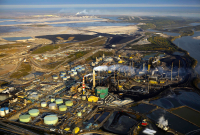Support strong Canadian climate journalism for 2025
The U.S. is on pace to leapfrog both Saudi Arabia and Russia and reclaim the title of the world's biggest oil producer for the first time since the 1970s.
The latest forecast from the U.S. Energy Information Administration predicts that U.S. output will grow next year to 11.8 million barrels a day.
"If the forecast holds, that would make the U.S. the world's leading producer of crude," says Linda Capuano, who heads the agency, a part of the Energy Department.
Saudi Arabia and Russia could upend that forecast by boosting their own production. In the face of rising global oil prices, members of the OPEC cartel and a few non-members including Russia agreed last month to ease production caps that had contributed to the run-up in prices.
President Donald Trump has urged the Saudis to pump more oil to contain rising prices. He tweeted on June 30 that King Salman agreed to boost production "maybe up to 2,000,000 barrels." The White House later clarified that the king said his country has a reserve of 2 million barrels a day that could be tapped "if and when necessary."
The United States led the world in oil production for much of the 20th century, but the Soviet Union surpassed America in 1974, and Saudi Arabia did the same in 1976, according to Energy Department figures.
By the end of the 1970s the USSR was producing one-third more oil than the U.S.; by the end of the 1980s, Soviet output was nearly double that of the U.S.
The last decade or so has seen a revolution in American energy production, however, led by techniques including hydraulic fracturing, or fracking, and horizontal drilling.
Those innovations — and the breakup of the Soviet Union — helped the U.S. narrow the gap, although Russia and Saudi Arabia both pumped more crude than the U.S. last year.
The U.S. has been pumping more than 10 million barrels a day since February, and probably pumped an average of 10.9 million barrels a day in June, up from 10.8 million in May, the energy agency said Tuesday in its latest short-term outlook.
Capuano's agency forecast that U.S. crude output will average 10.8 million barrels a day for all of 2018 and 11.8 million barrels a day in 2019, up from 9.4 million in 2017.
The current U.S. record for a full year is 9.6 million barrels a day in 1970.
The trend of rising U.S. output prompted Fatih Birol, executive director of the International Energy Agency, to predict this spring that the U.S. would leapfrog Russia and become the world's largest producer by next year — if not sooner.
One potential obstacle for U.S. drillers is a bottleneck of pipeline capacity to ship oil from the Permian Basin of Texas and New Mexico to ports and refineries.
"They are growing the production but they can't get it out of the area fast enough because of pipeline constraints," said Jim Rittersbusch, a consultant to oil traders.
Some analysts believe that Permian production could decline, or at least grow more slowly, in 2019 or 2020 as energy companies move from their best acreage to more marginal areas.





Comments